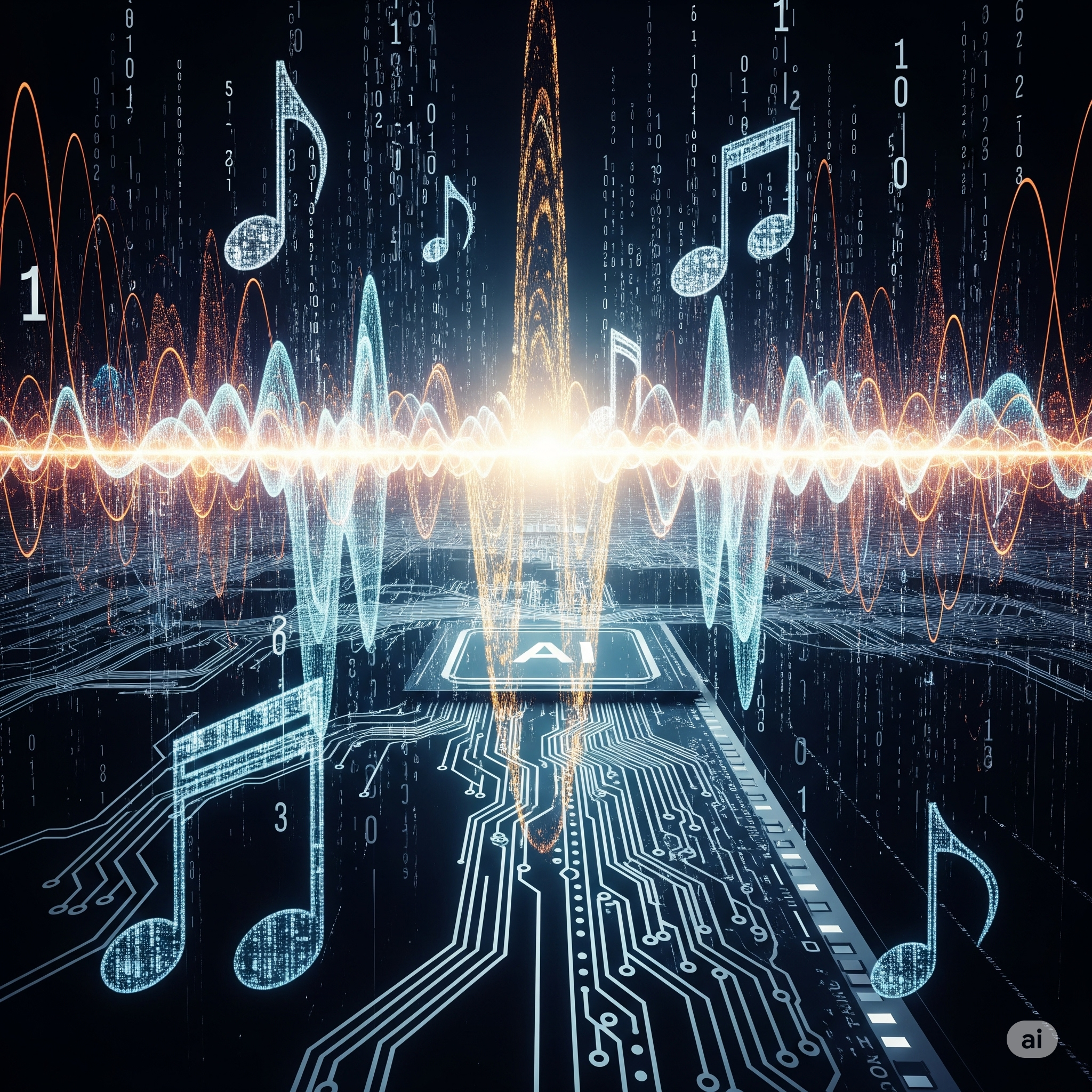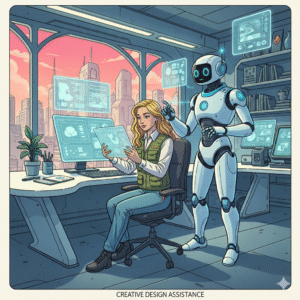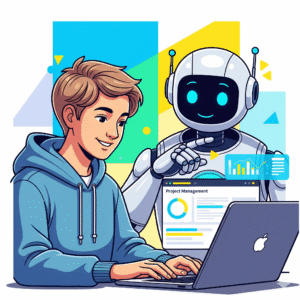The realm of music creation, once solely the domain of human ingenuity, is now experiencing a profound transformation with the advent of AI music production. What was once considered a deeply personal and artistic process is now being augmented, and in some cases, revolutionized by intelligent algorithms capable of generating melodies, harmonies, rhythms, and even entire musical arrangements. This isn’t about replacing human composers and musicians; rather, AI music production tools are emerging as powerful collaborators, offering new avenues for creativity, streamlining workflows, and democratizing music creation for enthusiasts and professionals alike.
The integration of artificial intelligence into music is no longer a futuristic fantasy. From sophisticated software that assists in composition to online platforms that generate royalty-free tracks, AI music production is rapidly becoming an integral part of the modern music landscape. Whether you’re a seasoned composer seeking new sources of inspiration, a content creator in need of unique background scores, or simply curious about the intersection of technology and art, understanding the capabilities and potential of AI for composers and producers is becoming increasingly essential. This article will delve into the exciting world of AI music production, exploring its applications, benefits, tools, and the transformative impact it’s having on the way music is created and consumed.
The Expanding Role of AI for Composers and Producers
The traditional music production pipeline, involving composition, arrangement, performance, recording, mixing, and mastering, is being touched by AI at various stages. For composers, AI for composers can serve as a powerful muse, generating initial melodic ideas, harmonic progressions, or rhythmic patterns that can then be further developed and refined. It can help overcome creative blocks by offering unexpected musical directions and sonic textures that a human might not have conceived on their own.
Producers, on the other hand, are finding AI music production tools invaluable for tasks such as generating realistic-sounding instrumentals, creating variations of existing tracks, and even assisting with mixing and mastering processes. Imagine being able to quickly generate several different drum patterns to see which best complements a melody, or using AI to analyze the sonic characteristics of a reference track and apply similar equalization to your own mix. The potential for efficiency and creative exploration is immense, allowing producers to focus on the higher-level artistic decisions and streamline the more technical aspects of music creation. The increasing sophistication of these tools highlights the growing importance of AI music production in the industry.
Unlocking Creative Efficiency: AI’s Time-Saving Applications Beyond Music
The ability of AI to enhance productivity extends far beyond the realm of music. In various industries, AI is proving to be a significant time-saver, allowing professionals to focus on strategic and creative endeavors rather than repetitive tasks. In the field of content marketing, for instance, AI-powered tools can assist in generating initial drafts of blog posts, social media updates, and marketing copy, freeing up marketers to concentrate on campaign strategy and audience engagement, as highlighted by resources on the HubSpot Marketing Blog.
Similarly, in project management, AI algorithms can analyze data to predict potential roadblocks, optimize resource allocation, and automate scheduling tasks, leading to significant time savings and improved efficiency, as discussed on platforms like the Zapier Blog. The legal industry also benefits from AI’s ability to quickly analyze vast amounts of legal documents, identify relevant precedents, and assist in drafting legal briefs, drastically reducing the time spent on research. Even in customer service, AI-powered chatbots can handle routine inquiries, providing instant support and freeing up human agents to deal with more complex issues. The common thread across these diverse applications is AI’s capacity to automate time-consuming tasks, allowing human professionals to allocate their valuable time and expertise to activities that require creativity, critical thinking, and strategic decision-making, much like AI for composers empowers musicians.
Real-World Use Cases: AI Shaping the Future of Music Creation
The impact of AI music production is already being felt across various musical domains. Here are a couple of compelling real-world use cases:
Use Case 1: Royalty-Free Music Platforms
Several online platforms now utilize AI music production to generate vast libraries of royalty-free music. These platforms cater to content creators, filmmakers, and businesses who need background music for their projects but may lack the budget or expertise to commission original compositions. Users can often specify parameters such as genre, mood, tempo, and instrumentation, and the AI will generate unique tracks tailored to their needs. This democratizes access to music and provides a cost-effective and efficient solution for obtaining high-quality background scores.
Use Case 2: Assisting Film and Game Composers
Professional composers for film and video games are also increasingly incorporating AI for composers into their workflows. AI tools can help generate initial sonic landscapes, create variations on existing themes, or even suggest harmonic possibilities that the composer might not have initially considered. This doesn’t replace the composer’s creative vision but acts as a powerful assistant, speeding up the ideation process and offering new sonic palettes to explore. The composer then takes these AI-generated elements and weaves them into their overall score, adding their unique artistic touch and ensuring the music effectively serves the narrative.
These examples demonstrate that AI music production isn’t just a novelty; it’s a practical tool that is changing how music is created and consumed in various professional and creative contexts.
Exploring the Toolkit: AI Music Production Software and Platforms
For those eager to dive into the world of AI music production, a variety of software and online platforms are available. Here are a few notable examples, along with practical tips for getting started:
General AI Music Production Tools:
- Amper Music (acquired by Shutterstock): While no longer accepting new users, Amper was a pioneer in AI-powered music generation, allowing users to create custom music by specifying mood, tempo, and style. Its legacy highlights the potential of AI in this field.
- Practical Tip (for similar tools): Experiment with different mood and genre settings to understand the range of musical styles the AI can produce. Start with simple prompts and gradually add more specific parameters.
- Soundful: This platform focuses on generating royalty-free music for content creators, offering a user-friendly interface and various customization options. Visit their website at Soundful.com.
- Practical Tip: Utilize the layering features to combine different AI-generated musical elements and create more complex arrangements.
- Loudly: Another AI music generator aimed at creators, Loudly offers a diverse range of genres and tools for customization. Find out more at Loudly.com.
- Practical Tip: Explore the “remix” or variation features to generate multiple interpretations of an AI-created track, potentially uncovering unexpected gems.
Specialized AI for Composers and Composition Tools:
- AIVA (Artificial Intelligence Virtual Artist): AIVA specializes in creating emotional and cinematic music and has even been credited as a composer on various projects, showcasing advanced capabilities in AI music production. Explore their work at AIVA.ai.
- Practical Tip: If you’re working on a film or game project, experiment with AIVA’s ability to generate music that evokes specific emotions or matches the pacing of visuals. Its algorithmic approach makes it a powerful AI for composers looking for sophisticated ideas.
- Orb Composer S: This more advanced software assists human composers by generating musical ideas, harmonies, and rhythms based on user-defined rules and parameters, making it a robust AI for composers. Discover its features at Hexachords.com/orb-composer.
- Practical Tip: Use Orb Composer S to overcome creative blocks by inputting a basic melodic idea and allowing the AI to suggest harmonic progressions or rhythmic variations, which can then be exported as MIDI.
AI in Music Production
- Google Magenta Studio: An open-source project by Google that explores the role of machine learning in the creative process. It includes various tools for generating melodies, drums, and even entire musical pieces. While not a commercial product, it’s a fantastic resource for experimentation for those interested in AI music production at a deeper level. You can find more information and download links on its GitHub page.
- Practical Tip: Experiment with different models within Magenta Studio (e.g., MusicVAE for variations) to understand how AI can transform existing musical ideas or generate entirely new ones.
- Melody ML: A user-friendly web application for generating melodies using machine learning. It’s an excellent starting point for those looking to quickly experiment with AI music production without needing to install complex software. Check it out at Melody.ml.
- Practical Tip: Input a simple sequence of notes or a short melody, and see how Melody ML can extend or vary it, offering fresh perspectives on your compositional ideas.
Beginner-Friendly Workflows for AI Music Production:
- Define Your Needs: Determine the type of music you want to create (genre, mood, tempo, length).
- Choose a Platform/Software: Select an AI music production tool that aligns with your technical skills and creative goals. Start with user-friendly platforms if you’re a beginner.
- Input Parameters: Use the tool’s interface to specify your desired musical characteristics. For AI for composers, this might involve defining scales, chord progressions, or rhythmic structures.
- Generate and Evaluate: Let the AI generate several musical options based on your input. Listen critically and select the ones that resonate with you.
- Customize and Refine: Most AI for composers tools allow for some level of customization. Edit melodies, adjust harmonies, change instrumentation, and refine the arrangement to match your vision.
- Add Your Human Touch: Even if the AI generates a complete track, consider adding your own instrumental performances, vocal melodies, or further sonic enhancements to make it truly unique.
Case Studies: Professionals Leveraging AI in Music
To further illustrate the practical application of AI music production, let’s examine two short case studies:
Case Study 1: Emily Carter, Indie Filmmaker
Emily, an independent filmmaker with a limited budget for original music, needed a captivating score for her short film. Instead of relying solely on stock music, she experimented with an AI music production platform. She input keywords describing the mood of different scenes (e.g., “suspenseful,” “melancholy,” “hopeful”) and specified the desired tempo and instrumentation. The AI generated several tracks that surprisingly aligned well with her visual narrative. Emily then selected the most fitting pieces and used basic editing software to adjust their length and intensity to perfectly match each scene.
The Result: Emily was able to create a unique and emotionally resonant soundtrack for her film at a fraction of the cost of hiring a composer. The AI music production tool provided her with a creative and budget-friendly solution, significantly enhancing the overall impact of her film.
Case Study 2: “Sonic Canvas Studios,” a Music Therapy Practice
Sonic Canvas Studios, a music therapy practice, wanted to create personalized ambient soundscapes for their clients to use during sessions and at home. They explored using AI for composers to generate unique and evolving sonic environments tailored to individual needs. By inputting parameters related to desired emotional states (e.g., “calming,” “focused,” “uplifting”) and preferred instrumental textures, they were able to generate a diverse library of ambient tracks.
The Result: Sonic Canvas Studios could now offer highly personalized music therapy experiences. The AI music production tools allowed them to create a wider range of sonic environments than they could have manually, saving significant time and expanding their service offerings. This demonstrates how AI music production can be applied in unexpected and beneficial ways beyond traditional music creation.
The Harmonious Future of AI and Music
AI music production represents a significant evolution in how music is conceived, created, and experienced. While concerns about AI replacing human creativity are understandable, the current reality paints a picture of powerful collaboration. AI for composers and producers offers unprecedented tools for inspiration, efficiency, and democratization in the music industry. From assisting seasoned professionals to empowering aspiring musicians and providing accessible music solutions for content creators, the applications of AI music production are vast and continue to expand.
Embracing this technological advancement doesn’t mean abandoning the human element that makes music so deeply resonant. Instead, it’s about leveraging the capabilities of AI to augment our creativity, overcome limitations, and explore new sonic frontiers. The future of music is likely to be a harmonious blend of human artistry and artificial intelligence, where technology serves as a powerful instrument in the hands of creative minds, leading to exciting new forms of musical expression and accessibility for all.
AI for Creative Writing: From Draft to Masterpiece
Unlocking Social Media Superpowers: Seamless Content Creation with Canva AI



